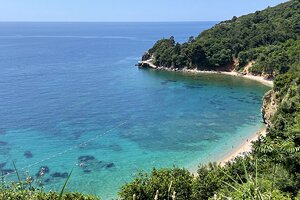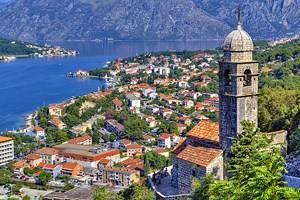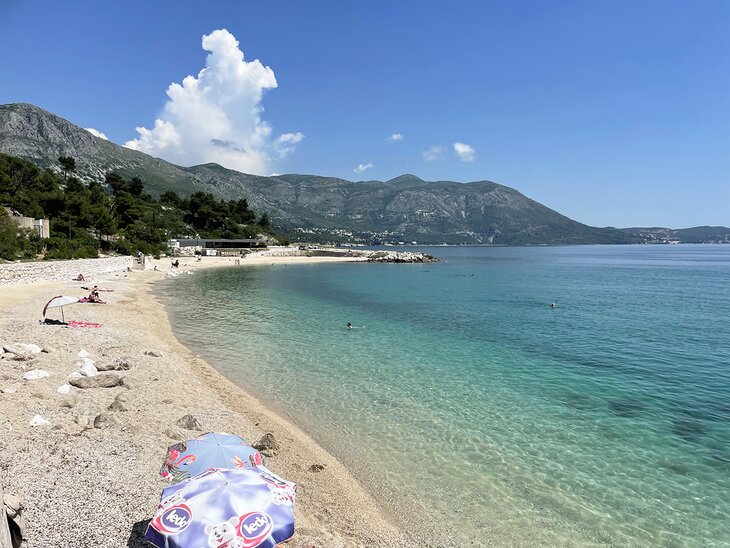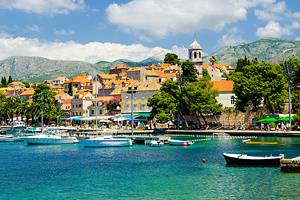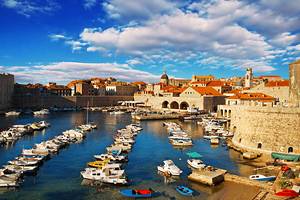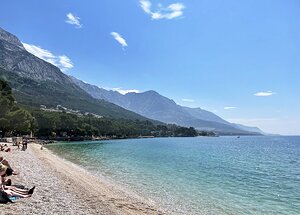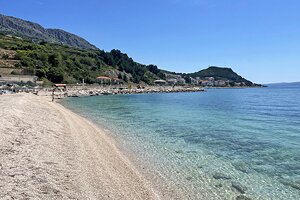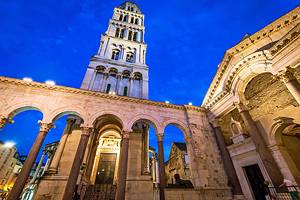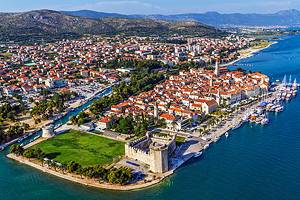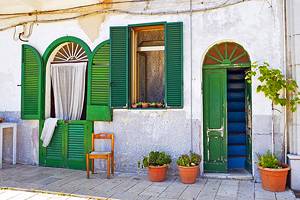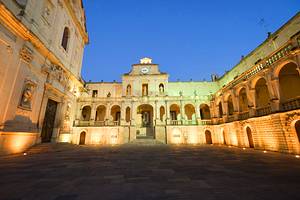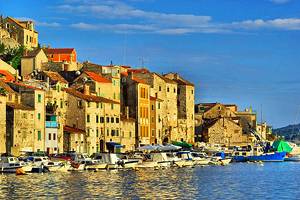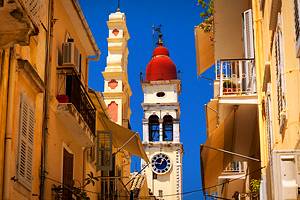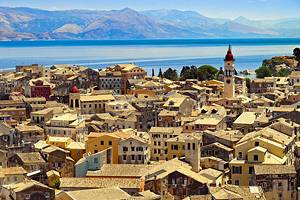Things to Do in Montenegro
With a population of just over 600,000 people, I mean it when I say Montenegro is small. But it is one of the most spectacularly beautiful places on the planet. That's because it has a similarly impressive Adriatic coastline to neighboring Croatia, towering limestone mountains, dozens of medieval villages, and the Bay of Kotor — arguably one of the most beautiful bays in the world.

Add to that a mild Mediterranean climate, fabulous food, interesting attractions and things to do, and pricing that is famously much lower than in other European countries, and you'll soon see why Montenegro is fast becoming one of Europe's top tourism hot spots.
I adored my time wandering the cobblestone alleys in the Venetian Old Town Kotor, gazing out to the deep blues of the fjord-like bay, sprawling on the splendid Riviera beaches, and hiking the mountainous interior.
For more ideas on the best places to visit, read my list of the top things to do in Montenegro.
Kotor Old Town & Bay of Kotor

You will fall in love with Montenegro the moment you cross the border. Most independent visitors fly into Dubrovnik in nearby Croatia and make the 90-minute drive down to Kotor. Other travelers' first foray into Montenegro is part of a cruise stopover, which also calls in Kotor. No matter which way you get there, you will be introduced to Montenegro with the spectacular Bay of Kotor.
The Bay of Kotor (also known as Boka Bay) is one of the most impressive bodies of water in the world. The deep blue, fjord-like bay is wreathed in towering limestone mountains and peppered with red-roofed medieval towns. At the southeastern edge of the bay is Kotor's Old Town, a magical fairy-tale 9th-century city that is packed with secrets to discover.

Old Town was my absolute favorite part of Montenegro: wandering the stone alleyways and narrow side streets, having coffee at one of the many outdoor cafes, and meeting the (dozens) of friendly cats that call the city home.
Visitors to Old Town will want to stop at the 12th-century Cathedral of Saint Tryphon, known for its carved stone altar. If you want a bit of exercise, you can climb the 1,300-plus steps up the mountain to the San Giovanni Fortress, which was built in the 9th century. From here you'll have the best sweeping views over the walls, Old Town, and Boka Bay.
Read More: Things to Do in Kotor, Montenegro
Budva Riviera

Stretching along the central Montenegrin coastline with Budva as its anchor city, the Budva Riveria is one of the area's main attractions and a hot summer beach destination for locals and tourists alike. The beaches here are a mix of sand and pebbles, backed by the clear, turquoise and aquamarine-blue hues of the Adriatic Sea on one side and dramatic mountains on the other.
There are a number of quality beaches along the Riviera, including Mogren Beach, which is the closest to Old Town Budva at just a five-minute walk along a seaside pathway from town. The beaches along the Budva Riviera are also lined with restaurants with outdoor seating.

Old Town Budva has a history that dates back 2,500 years. This medieval walled city has a lively atmosphere and is filled with restaurants and shops, as well as a town museum.
Our Lady of the Rocks

Out in the center of Boka Bay, just off the coast of the historic village of Perast, is a man-made lake topped with a gorgeous church. The church, known as Our Lady of the Rocks, originally dates back to the 15th century. Its history, plus its position on the lake surrounded by stunning mountains, will make even non-believers feel something spiritual.
I took a private boat tour of Boka Bay, which included a stop at the island and the opportunity to wander around the church. The views are awe-inspiring from every angle. The church has a robin's egg blue dome and red tile roof, which contrasts beautifully against the white stone and green of the mountains.
The church you see today is from the 17th century, as the original church was destroyed in an earthquake.
Lipa Cave

One of the largest caves in Montenegro, Lipa Cave, just a few kilometers from the village of Cetinje, is in the mountains north and just east of Budva. The cave was first discovered accidentally by a dog who fell through a hole into it, but managed to escape safely through another opening.
Today, the karst cavern is also one of Montenegro's most popular tourist attractions for adventurous kids and adults alike. A visit begins with a ride on a miniature train through the wild countryside, full of pomegranate and wild fig trees, to the cave's entrance. From here, you'll join a guided tour through some of the 3.5 kilometers of passages and great halls carved by thousands of years of dripping water and its underground river.
Lake Scadar

Lake Scadar, on the border with Albania, is the largest natural lake in Southern Europe. It is a great back-to-nature destination that hosts multiple species of migratory birds and other wildlife. The Montenegrin side of the lake has been designated as a national park. Explore the lake on a boat excursion and also spend some time checking out the villages dotting it. Many date back to the 13th century and have been designated as UNESCO World Heritage sites.
On the lake's southwestern shore, you'll find Murici Beach, which is a pristine and quiet stretch of shoreline backed by the beautiful Rumija Mountain Range. The beach can be accessed via a steep road to a small village at the edge of the lake. This is a great spot to just escape and breathe in the fresh air and countryside ambience.
Also, don't miss the Pavlova Strana viewpoint in the national park. From here, you'll see the horseshoe bend of the Rijeka Cronjevica River, which flows around a small, round mountain on its way into the lake. The lush green of the surrounding trees and hills juxtaposed against the blue of the river is stunning.
The viewpoint is about a 30-minute drive from Cetinje off the M2.3 highway. You'll reach it on a very narrow one-lane road with lots of tight hairpin bends, so drive carefully.
Ulcinj

Not far from the Albanian border at Montenegro's southern tip, Ulcinj is an ancient seaport that was once infamous as the Adriatic Sea's pirate capital. Today, Ulcinj is a unique Montenegrin town with a largely Muslim population and some beautiful mosques and excellent restaurants and coffee shops along its peaceful seaside promenade.
The area is also known for its beaches, including Velika Plaza (which translates to "Big Beach"), and at 12 kilometers is Montenegro's longest beach. The water here is very shallow and great for families with small children. If you are a person who prefers a sandy beach over the traditional pebbly beaches you find in Croatia and Budva, you'll love Velika Plaza for its soft, fine sand.

It is also a top spot for kitesurfers, who take advantage of the glassy smooth and shallow water and prevailing winds to catch a ride. If you'd like to learn more about the sport, there are a number of kitesurfing schools at the southern end of Velika Plaza.
Cetinje

The 15th-century town of Cetinje once served as Montenegro's capital during the late 19th and 20th centuries (prior to WWI when it was still an independent country). At the time, the inland valley locale at the edge of what was then the Ottoman Empire made it a coveted spot to conduct diplomacy.
Today, the embassies have been turned into museums, government buildings, and educational academies, and the town is a pleasure to wander aimlessly about for an afternoon. The Cetinje Monastery here has a collection of Early-Christian-era relics you can see for a donation, and the Vlah Church dating back to the 15th-century is another notable sight.
Mount Lovcen

Montenegro's name was inspired by the towering granite peaks of Mount Lovcen, and the mountain is a source of national pride. Protected as a part of Mount Lovcen National Park, the views from the circular platform at the top are truly stunning and have you looking down upon the Bay of Kotor and the medieval city of Kotor on its shores.
Also nearby is Njegos Mausoleum, where you can pay your respects to the author of Montenegro's national epic poem, "The Mountain Wreath." Its poet Petar II Petrovic-Njegos is buried here. The village of Cetijne is the main base for this park and where you'll find a number of hotel and restaurant options.
Perast

On the same beautiful bay as Kotor but located just to the northwest, Perast is a picturesque small town notable for its multiple churches and stone-crafted villas. In town, the Church of St. Nikola has great views of the town and the Bay of Kotor from its belfry tower.

Two of Perast's most charming churches, Our Lady of the Rocks and St. George, however, are on tiny islets in the bay. The town does not have a beach, but the stone jetties along its bayfront are popular summer spots for sunbathers.
Perast can be combined with a trip to Our Lady of the Rocks, or you can visit from land on your own.
Sveti Stefan

On the Budva Riviera, Sveti Stefan is connected to the mainland by a narrow isthmus and has been inhabited since the 15th century. Back then it was a simple fishing village. The town came to be known in the 1950s when it was turned into a luxury resort area, and guests like Marilyn Monroe and Sophia Loren would holiday here.
Following a downturn at the end of the 20th century as the Yugoslav federation collapsed, today it is again a vacation paradise, with two beautiful pebble beaches on either side of the isthmus. Although the beaches are public, the original village is only open to visitors staying at the Aman Resort here.

If you want a beautiful bird's eye view of the village, you can find a lookout point on the highway that looks down directly over it. If you're coming from Budva, the lookout point is just before the turnoff to go down to the beach.
Durmitor National Park

Near the mountain town of Žabljak, Durmitor National Park is another popular natural attraction. The park sits in the Dinaric Alps and is home to some 18 glacial lakes, the Tara River, and the world's second-deepest canyon (see Tara Canyon below).
Of the lakes in the national park, one of the best ones to visit is Black Lake. Once here, you can hire a kayak and explore the crystal-clear, jade and turquoise water from its helm. Or follow the four-kilometer track that meanders around the lake itself. It's an easy walk, and you'll pass historic caves along the way. Black Lake is also a great place to bring a picnic and just relax.
The park is also home to thick areas of forest and wildlife, from brown bears to wild boars, and 163 different species of birds. There are opportunities to go skiing or snowboarding here in winter, and in summer, you can hike, camp, and white water raft among other activities.
Tara Canyon

Tara Canyon is another of Montenegro's amazing natural wonders. After the Grand Canyon, it is the world's deepest canyon, and just like the Grand Canyon, it can be experienced with an epic whitewater rafting trip. Note that the water is a bit on the chilly side, however, at around 50 degrees Fahrenheit.
If you don't want to get wet, you can also see the canyon from the Ðurdevica Tara Bridge. The concrete arch bridge was rebuilt after WWII when it was blown up in an effective attempt to stop the Italian invasion.
Today, the bridge is 172 meters above the canyon floor and besides taking in views from it, adrenalin junkies can ride across the canyon on a zipline.
Ostrog Monastery

Built during the 17th century as a refuge against Ottoman Empire invaders, Ostrog Monastery is now a major Christian pilgrimage destination. Set atop a large granite outcropping, the entire monastery was carved from a cave on a nearly vertical cliff.
It is quite an impressive site, with two inner cave churches that can be visited. They are bedecked with frescos painted right onto the rock walls. The monastery also houses the remains of its founder, Sveti Vasilje, who became a saint after his death in 1671.
Biogradska Gora National Park

Montenegro has designated quite a bit of land to national parks, including the beautiful Biogradska Gora National Park in the center of the country. Set between the Lim and Tara rivers, it is filled with fast-running streams; sparkling, clear lakes; flower-filled meadows; and one of Europe's last primeval forests, where the trees are 500 years old.
The top natural attraction in this park is Lake Biograd, which is a large glacial lake in the middle of the park. The nearby town of Kolasin makes a good base with lodging and restaurants.



